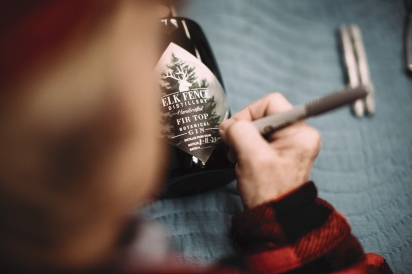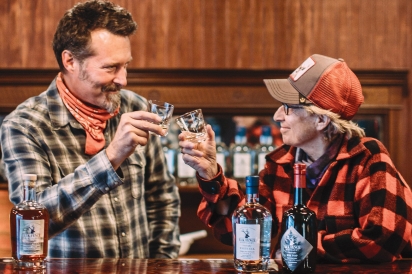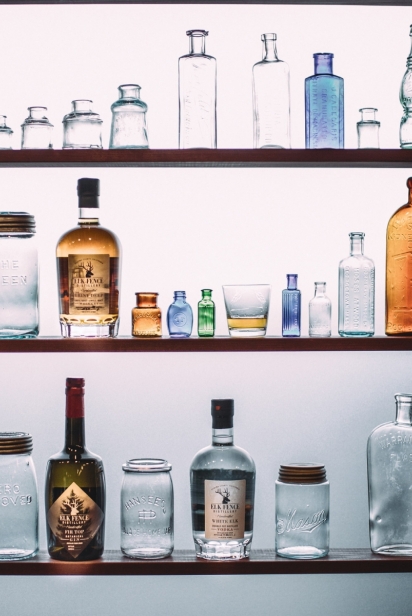Distill My Heart
THE ALCHEMISTS OF ELK FENCE DISTILLERY
“When alchemists first learned how to distill spirits, they called it aqua vitae, the water of life, and far from considering it the work of the devil, they thought the discovery was divinely inspired.”
—Gene Logsdon, Good Spirits: A New Look at Ol’ Demon Alcohol (Chelsea Green, 2000)
“Our inspiration for Elk Fence spirits comes from the many beautiful diverse places throughout Marin and Sonoma counties we love. We work to capture those essences in a bottle.”
—Scott Woodson, co-founder, Elk Fence Distillery
Scott Woodson and Gail “Shorty” Coppinger are the alchemists of Elk Fence Distillery, a small-batch craft distillery specializing in American single-malt whiskey, botanical gin and vodka. Their quest to create spirits that evoke the places they love has been a labyrinthian journey of discovery.
The distillery co-founders and business partners met in the early ‘90s when they were both working on the same custom home project. Scott is a painter and Gail is a shingler. By the time the long project was completed, they were fast friends, having discovered that they shared a passion for cooking, beer and whiskey. Scott was an excellent home chef and brewer, and Gail had previously been a line cook and she also owned the Golden Point Produce shop next to Cowgirl Creamery in Point Reyes Station.
In 2014, Scott stopped by the shop one day and invited Gail to help him make some beer. “I jumped at the chance,” Gail said. “I walked into his garage and all of this equipment was set up. We made a barley mash; the smell was amazing.”
It wasn’t long before the duo decided to explore making distilled spirits together. Scott said, “It’s a pretty arduous process, little did we know.” Gail echoed Scott, “It’s true we didn’t really know how hard it would be but here we are, up and running.”
As their distilling journey began, they were growing barley for their beer on the Kehoe Ranch on Tomales Point in West Marin. The elk fence running alongside the barley field inspired the distillery name, but from there things got a lot more complicated.
First of all, the alcohol and beverage industry is rife with antiquated laws. In particular, federal “tied house” regulations— enacted at the end of Prohibition to prevent collusion among alcohol producers, distributors and retailers—bind a license to distill, which is required, to a particular location that must be owned or leased by the distiller.
Scott and Gail’s search for an appropriate location took over a year. In the meantime, they researched equipment and sought opportunities to experience hands-on distilling (it’s illegal to distill outside of a licensed facility).
As part of their ethos for Elk Fence, Scott and Gail sought out high-quality, American-made equipment. For a long time, the cost seemed daunting. Their “genie in a still” appeared in the form of Jesse Lupo, founder of Trident Stills in Maine, who granted them their wishes. Trident’s handmade stainless steel and copper stills are designed with small-batch distillers in mind, and Lupo was willing to offer them a payment plan. He also agreed to spend a week at Elk Fence, and directed Scott and Gail to attend two “distilling schools” at small batch distilleries in Kentucky and Pennsylvania that use Trident stills before their own equipment arrived. “He wanted us to get the most out of his stills,” Scott said. “The week he arrived, when we started everything up, was intense. It was great that he was here and running through everything with us.”
Once they found the right location, which included a landlord enthusiastic about having them, they started working with their lawyers on required permits and the license to distill. This, in turn, helped them attract investors that they would need to fund the venture.
It all seemed to be coming together, until Gail received a call from their lawyers. “We need a conference call with both of you, tomorrow at noon,” she recalled hearing. The attorneys wouldn’t reveal the reason for the urgency over the phone, and Gail says she was certain their application was being denied.
They learned on the call that “tied house” regulations also direct that if someone living in the applicant’s same household works for a company that holds more than two liquor licenses, the applicant is ineligible. Scott’s then wife, Cat Cowles, works for Hog Island Oyster Company, which, because of its multiple locations, holds more than two licenses. “They said the only way [for me] to get the license was to divorce my wife,” said Scott. “I went home and over dinner I told Cat. She quickly answered, ‘OK,’ which was a little disturbing, but we laugh about it now.” Happily a couple for over 20 years now, Scott and Cat had been officially hitched for five years when, in 2017, they did in fact get a divorce so that Elk Fence Distillery could obtain its license to distill. Gail joked, “We all decided that one day we were going to make a special ‘Living in Sin Gin.’”
Next, they needed to source their ingredients. They knew that growing, harvesting and processing their own barley into malt as the base for their spirits wasn’t feasible, but they still wanted to source it locally, and from someone who is a master at the malting process. Gail explained, “Malting is a complicated process of barely germinating the barley kernel to maximize the protein. Then you arrest that development at the perfect point by drying it out. There aren’t very many malt houses in America, and very few that are using local grains. Fortunately, we discovered James Mahon at Grizzly Malt in Rohnert Park. When he brings the malted barley to us it’s still warm from the drying process—crackly and delicious. It makes for really good distillate. We also get grain from a malt house in Alameda, Admiral Maltings. They use really nice grain from Solano County. We order from both of them, depending on what we need.”
Gail described the next steps: “You cook a porridge with your malted grains and water [Elk Fence uses reverse osmosis filtered water], then put it in a fermentation tank and add yeast. The yeast eats the sugar and turns it into alcohol. From that point it goes into a stripping still to strip out all the alcohol. After that it goes into a finishing still, and that’s where you make your cuts.”
It’s while making the “cuts” that the distiller is most effectively serving as alchemist. While other techniques, like adding botanicals to the base spirits in crafting gin, are also used for creating flavor, cutting is the most impactful according to Scott and Gail. The earliest part of the extraction produces the “heads,” which are toxic and should be discarded. Next to flow are the “hearts,” which are compatible with the human body, and last are the “tails,” which can have negative impacts on the body, but used in very small amounts help to flavor whiskey. Gail expounded, “We make our cuts really deep, to save only the hearts and a fraction of the tail for making our whiskey.”
Tasting all three of Elk Fence’s spirits—a whiskey, a gin and a vodka—I was struck by the cohesive blend of flavors in each spirit, as well as the clear sensory conjuring of singular places here in Marin and Sonoma counties. In particular, The Briny Deep Whiskey tasted like a hot fall day, walking above Marshall as the Pacific Ocean-scented fog rolls in and releases the perfume of bay leaves and dry grass, lit up by the moisture.
I asked Scott and Gail about what guides them in their shared craft at Elk Fence. “Our spirits are often quite romantic in nature, but grounded in sound historical text,” said Scott. I was drawn to the mid-1800s distilling texts, which set a solid, important foundation of excellent distilling techniques. Old texts on French perfumeries were another source of historical knowledge.”
As a proof point, Elk Fence’s vodka isn’t distilled numerous times, as most vodkas are in a quest to obtain the industry standard “devoid of flavor.” I found the distillery’s White Elk Vodka to be smooth, silky and refreshing.
“We wanted our Fir Top Gin to be an adventurous and playful spirit,” Scott said. “Fir Top will keep you guessing— what is that I’m tasting?—and wanting more. It’s a mystery and everyone likes to solve a good mystery.”
Gin is my own favorite spirit, and I loved that Fir Top was a perfect “spirit perfume”—hard to name the individual ingredients.
“It’s magical. It’s the alchemy and the chemistry. It’s a magical thing that happens,” said Gail.
Until visitors are allowed into their tin-ceilied tasting room that has been designed and furnished with the same attention to detail as their spirits, including a restored redwood long bar from the 1860s, upright Steinway piano and an antique bottle collection (many of which Gail dug from the ground herself), Elk Fence Distillery offers local delivery and curbside pickup.
@elkfencedistillery, ElkFenceDistillery.com








